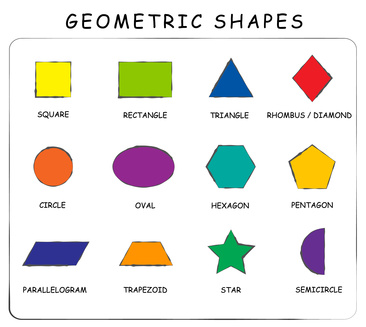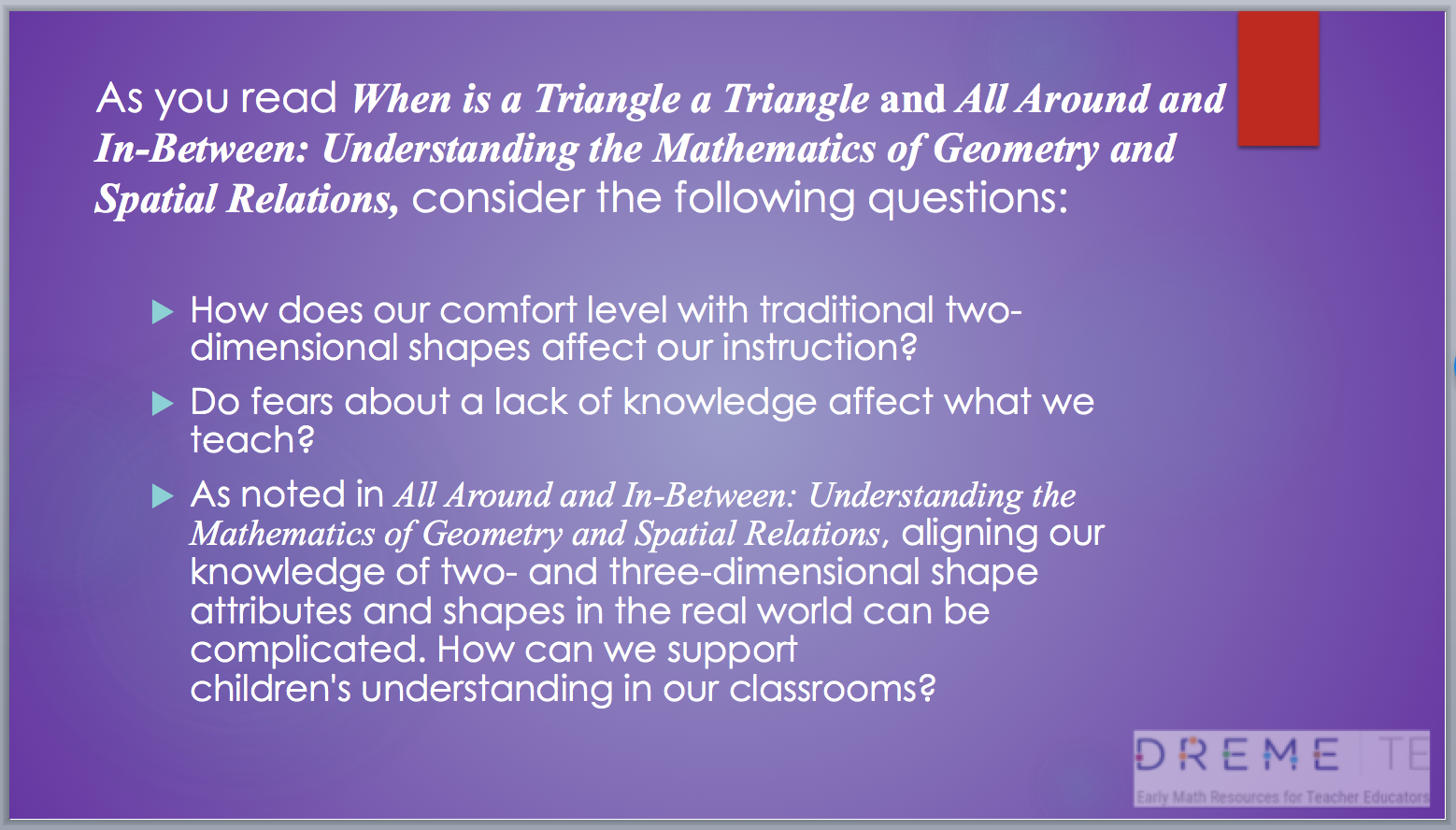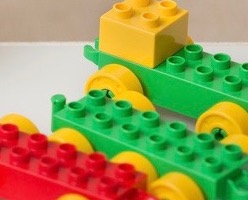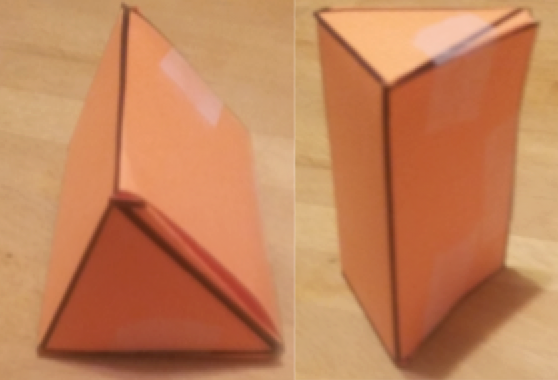The story of a preschool teacher leveraging children's ideas to engage in geometry. It addresses anxiety teachers experience when working beyond simple shapes, offering a perspective that engages participants and the children they teach.
Teacher Steffi’s class had just returned from the school library where each child had checked out a book with a brand new library card. Nayeli and Noelle were sitting on the rug with their books waiting for Teacher Steffi to begin reading. Nayeli was looking at her book of shapes that was opened to a page with triangles in different sizes and orientations. Noelle looked over from her picture book and asked, “Nayeli, what are those?” Nayeli answered, “This is a triangle [pointing at a stereotypical equilateral triangle]. But, I don’t know what this is [pointing to a long and narrow triangle].” Noelle answered, “I think it’s an arrow” and went back to reading her own book. Teacher Steffi had been listening in while waiting for the rest of the children to finish washing their hands and settle in for circle time. She decided to take a look at the page that the girls were discussing.
During naptime, Teacher Steffi took the book out of Nayeli’s cubby. It was an engaging book, filled with pages of geometrical shapes in whimsical settings. But what was unusual was that the book included not only familiar shapes (diamonds, hearts, circles, stars, and squares) but also very unusual looking shapes. She wasn’t even sure  what they were. Could triangles be three times as long as they are wide? Are they still triangles then? Does a square turned so that the vertices are at the top and bottom instead of at a diagonal become a diamond? Or is it still a square? The more she looked at the shapes, the more she worried that she didn’t really know anything about teaching shapes! Why do they all look so different from the shape poster on the wall? She had taken geometry in high school, but that was a long time ago (and her grade wasn’t so great in that class either).
what they were. Could triangles be three times as long as they are wide? Are they still triangles then? Does a square turned so that the vertices are at the top and bottom instead of at a diagonal become a diamond? Or is it still a square? The more she looked at the shapes, the more she worried that she didn’t really know anything about teaching shapes! Why do they all look so different from the shape poster on the wall? She had taken geometry in high school, but that was a long time ago (and her grade wasn’t so great in that class either).
Steffi cared deeply about teaching and the children in her classroom. She had always tried to anticipate children’s questions; she knew that what she did in the classroom could have long-term consequences. What if Nayeli and Noelle asked her about the shapes? She decided to look online to see if there was a website that defined shapes.
That night, after dinner (and after landing on quite a few unhelpful sites) she found a site that illustrated and defined a lot of the same kinds of shapes she had seen in Nayeli’s library book. It was actually kind of fascinating! There were pretty clear rules about how shapes were classified. Once you figured that out, it was simple. Triangles are closed figures with three sides and three angles. She thought, “Huh. Wow. That’s really easy!” She went on to look at the definitions of squares (closed figures, four right angles, and four sides of equal length), rectangles (closed figures with four right angles and opposite sides of equal length), and rhombuses (or rhombi) (closed figures with four sides of equal length, where the opposite angles equal). It was almost like a game. Even when she came to three-dimensional figures, there were pretty easy rules. Prisms and pyramids are named after their bases. It all seemed to have patterns to it, something that she knew was exciting to the children in her classroom, and also important to later math achievement. Before bed, she printed a few pages to save for reference.
 A few mornings later Steffi pulled out a set of large two-dimensional shapes that she had in the math center. During circle time, after reading some of Nayeli’s book aloud, she started asking children questions about the shapes from the math center. "What do we know about this shape? What do you notice about this shape? Does this shape look like any other shape that we know? How does it look different from other shapes?" Soon, the children were chiming in over one another, “It’s flat on the sides!” “It’s fatter than a circle!” “It’s longer than a square!”
A few mornings later Steffi pulled out a set of large two-dimensional shapes that she had in the math center. During circle time, after reading some of Nayeli’s book aloud, she started asking children questions about the shapes from the math center. "What do we know about this shape? What do you notice about this shape? Does this shape look like any other shape that we know? How does it look different from other shapes?" Soon, the children were chiming in over one another, “It’s flat on the sides!” “It’s fatter than a circle!” “It’s longer than a square!”
Over the next several weeks as children gained more and more familiarity with shapes, Steffi began to introduce some of the more formal vocabulary that is used to describe shapes. She pointed out the four sides of a square. She talked about the number of angles in a triangle and that it had to be closed (no spaces in or between the sides). She explained that the opposite sides of rectangles had to be the same length and the same distance apart. She also explained that a lot of rectangles that we see have two sides that are longer that the others, but that actually wasn’t part of the rules about rectangles. She then invited the children to describe squares and rectangles, and asked how they might be the same or different.
One day, with some nervousness, Steffi pulled out a dusty set of three-dimensional foam shapes. The children had learned how to describe two-dimensional shapes over the last few months and using this vocabulary helped them describe three-dimensional shapes. Soon they were off and running using a mixture of formal and informal terms. She hesitantly introduced a group of pyramids (which they had read about in a recent story about ibises and crocodiles in Egypt) and was amazed that once the children learned to tip the pyramids upside down and match their bases to what they knew about two-dimensional multi-sided shapes (polygons like triangles, squares, pentagons and hexagons), they were fascinated by naming them. In particular, Nayeli, laying them all on their sides with the bases towards her, pointed to each one slowly stating its name, including triangular pyramid, square pyramid, pentagonal pyramid, and hexagonal pyramid. As she went down the row of pyramids, a smile slowly grew over her face. By the end, she was grinning with her accomplishment. “I guess that isn’t much harder than learning the names of a diplodocus, triceratops, and a tyrannosaurus rex,” Steffi thought to herself.
So, when is a dinosaur a triceratops? When it has a three (tri) horned (cerat) face (ops). When is a prism a hexagonal prism? When the bases are hexagons. When is a triangle a triangle? You tell me.



